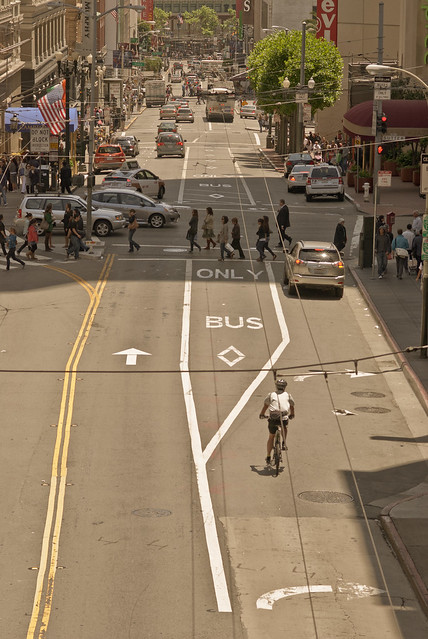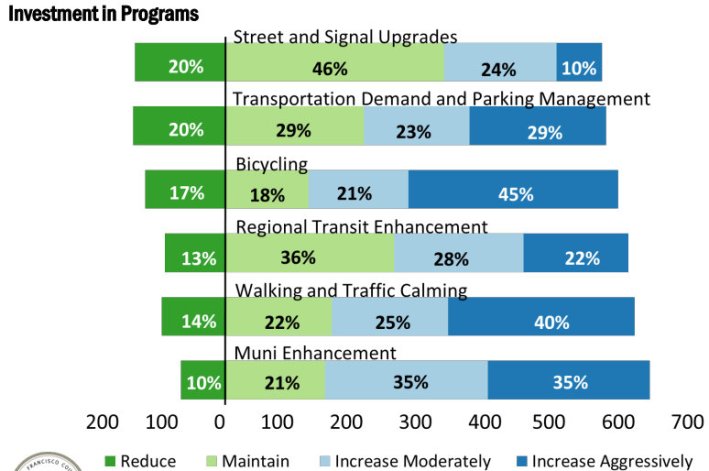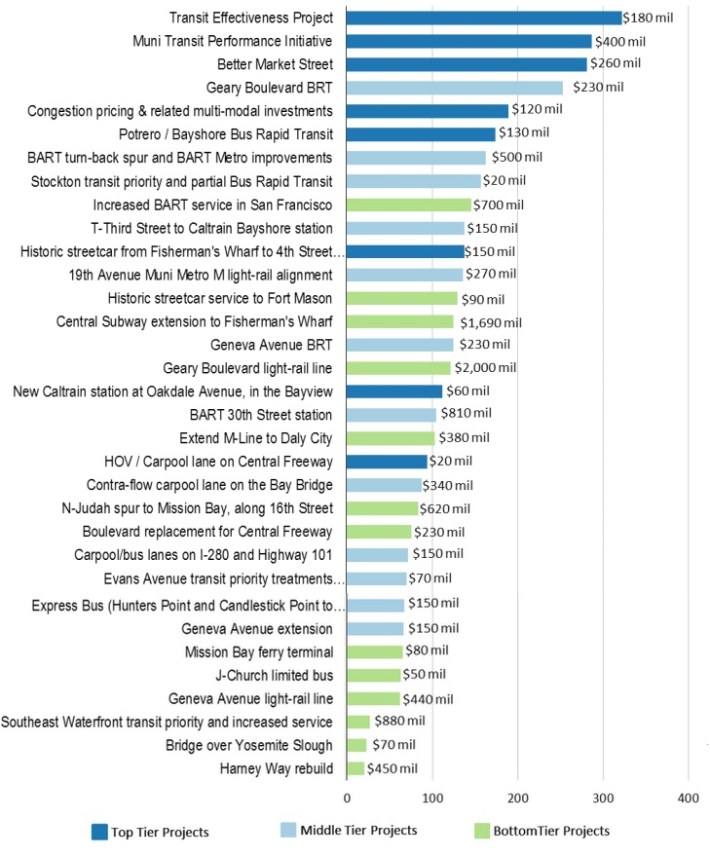Survey: SF’s Top Transpo Priorities Are Fixing Muni, Safer Walking and Biking
5:39 PM PST on January 23, 2013
San Francisco's scarce transportation funds should be used to make streets safer for walking and biking, and to make existing Muni service more reliable before expanding it, according to city residents who were asked to choose how to prioritize public spending.
The findings come from the "Budget Czar" game, an online budgeting simulator recently used by the SF County Transportation Authority to survey the public about how to spend discretionary funds in the agency's 25-year San Francisco Transportation Plan.
Of the $64 billion in transportation funding the SFCTA expects to spend over the next 25 years, just $3.14 billion -- 5 percent -- is not already committed to maintaining the existing state of street and transit infrastructure, or to transportation projects already in the works.
When the more than 800 "Budget Czar" participants were asked how they would spend that slice of the pie, they heavily favored improving the core of the existing Muni system rather than expanding it. Of the six spending categories that participants were asked to weigh in on, the top three where they want to see an "aggressive" increase in funding were bicycling (45 percent), walking and traffic calming (40 percent), and "Muni enhancement" (35 percent), according to an SFCTA presentation [PDF] last week.
"It's great to see that the transportation priorities of the San Franciscans who played the budget game resonate so well with Livable City's," said Tom Radulovich, executive director of Livable City.
"San Franciscans understand that investments in active transportation -- walking and cycling -- are cost-effective and sustainable, and deliver a range of benefits -- improved health, neighborhood vitality, less traffic and pollution, a more equitable city, a safer city for children and seniors, and greater enjoyment," he said.
Respondents also heavily favored improvements to existing transit service over more costly capital projects. The SFCTA laid out a list of 33 proposed transportation projects, including everything from new Bus Rapid Transit projects to new BART stations to removing the Central Freeway. According to an SFCTA report [PDF], the top-ranking projects were the Muni Transit Effectiveness Project, the Muni Transit Performance Initiative (a set of fixes for "key bottlenecks" like a Muni Metro turnaround at Embarcadero Station), the Better Market Street Project, and Geary BRT.
"The public's strong support for reinvesting in existing transit -- state of good repair, greater speed and reliability, improved safety, accessibility, and capacity, and increased funding -- makes good sense," said Radulovich, "and confirms the polling results from Proposition K, San Francisco's transportation sales tax, and Measure B, Alameda County's recent sales tax measure."
Congestion pricing also saw "quite a bit of support, but also some skepticism" from respondents, according to the SFCTA report. The agency did note that demand-based parking pricing, the approach used under SFPark, was a popular policy. Other key takeaways, according to the SFCTA, were calls to reform city bureaucracy to deliver improvements more quickly and cost-effectively and to seek out more transportation revenue overall.
While it's clear bicycle infrastructure is in high demand -- and will be critical for the SF Municipal Transportation Agency to build out the vision in its upcoming Bicycle Strategy -- even the SFCTA's most "aggressive" vision for increasing bicycle funding may not be enough. Dave Snyder, executive director of the California Bicycle Coalition and a long-time San Francisco bicycle advocate, pointed out that under the most ambitious scenarios included in the "Budget Czar," funding for bicycling would still only amount to $6 million per year, or 0.23 of the city's projected transportation spending (up from the status quo of 0.08 percent).
If San Francisco is to reach its goal of 20 percent of trips by bike by 2020, Snyder said that amount would be far from enough to fund the necessary programs, such as a network protected bike lanes, secure bike parking at transit stations, a citywide bike-share system, and bicycle education and promotional campaigns.
"If less than one quarter of one percent is considered 'aggressive' by the Transportation Authority Commissioners, well, their resolutions in support of bicycle-friendliness should be seen as the greenwashing of a non-bike-friendly transportation policy that it really is," said Snyder.
"I look forward to a more realistic analysis of a truly bicycle-friendly transportation program, and to our advocacy for the funding that it will take to build it," he added.
The SFCTA says it's using this public feedback to inform a draft version of the Transportation Plan, which is expected to be released this spring before the final version is approved in the summer. Radulovich urged the SFCTA to heed the public's advice, noting that "the transportation priorities of everyday San Franciscans are not always reflected in the decisions of transit and funding agencies."
Livable City is "keen to see the updates to our Countywide Transportation Plan, SFMTA Strategic Plan, and General Plan embrace the public's transportation priorities by expanding the city's commitment to complete streets, active transportation and programs like Sunday Streets, reinvestment in core transit services, and making transit financially sustainable," he said.
Read More:
Stay in touch
Sign up for our free newsletter
More from Streetsblog San Francisco
Independent Safety Advocates Beef up the Wiggle
Signs and soft-hit posts installed by advocates make the Wiggle bike route calmer and safer for cyclists and pedestrians







